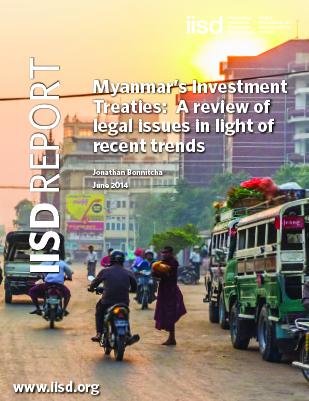| 来源类型 | Paper
|
| 规范类型 | 论文
|
| Myanmar’s Investment Treaties: A review of legal issues in light of recent trends |
| Jonathan Bonnitcha
|
| 发表日期 | 2014-09
|
| 出版者 | IISD
|
| 出版年 | 2014
|
| 页码 | 36
|
| 语种 | 英语
|
| 概述 | This paper reviews Myanmar’s existing investment treaties and examines the legal and policy implications of key terms contained in them.Read More |
| 摘要 |
This paper reviews Myanmar’s existing investment treaties and examines the legal and policy implications of key terms contained in them. The purpose of the paper is to provide an overview of Myanmar’s current investment treaty context, which can inform a way forward for possible reform and contribute to a deeper understanding of the implications of potential future treaties. The paper focuses on key provisions that have proven important in other countries’ experience with investment treaties over the past decade. The main findings of the paper are as follows: - Myanmar has seven investment treaties in force, plus an eighth treaty—the Myanmar–Japan bilateral investment treaty (BIT)—that may soon enter into force.
- Myanmar’s investment treaties cover the investment relationship between Myanmar and 15 other countries. These 15 countries are all located in East, South-East and South Asia and in Oceania (Australia and New Zealand).
- Four of Myanmar’s investment treaties, which cover Myanmar’s investment relationship with 13 different countries, were negotiated either with or through ASEAN.
- Myanmar’s investment treaties that were negotiated with or through ASEAN show some degree of consistency, although important differences between these four treaties remain. In contrast, there is a very high degree of variation between Myanmar’s ASEAN investment treaties and Myanmar’s BITs, both in the types of provisions included in different treaties and in the drafting of provisions common to several treaties.
- These variations have significant legal implications for the nature and extent of Myanmar’s obligations under different treaties. They also make the government’s task of complying with Myanmar’s existing investment treaties more complex.
- Many of Myanmar’s investment treaties contain most-favoured nation (MFN) clauses. The effect of these provisions is that any benefit extended to foreign investors from one country under one investment treaty may need to be extended to foreign investors covered by Myanmar’s other investment treaties. As a result, Myanmar may be required to grant a combination of benefits to foreign investors that is more generous than that provided by any one of Myanmar’s investment treaties, considered individually.
- Aside from the Myanmar–Philippines BIT, all of Myanmar’s investment treaties allow foreign investors to bring claims under the treaty directly to investor–state arbitration. In such disputes, an arbitral tribunal will decide if the state in which the investment is located has breached the treaty. If the investor’s claim is successful, the tribunal will make a binding, monetary award against the state.
Because Myanmar’s investment treaties are enforceable through investor–state arbitration, questions relating to the extent of Myanmar’s obligations under different treaties have important practical implications. |
| 主题 | Investment for Sustainable Development
; Trade
|
| URL | https://www.iisd.org/library/myanmar-investment-treaties-review-legal-issues-light-recent-trends
|
| 来源智库 | International Institute for Sustainable Development (Canada)
|
| 资源类型 | 智库出版物
|
| 条目标识符 | http://119.78.100.153/handle/2XGU8XDN/57491
|
推荐引用方式
GB/T 7714 |
Jonathan Bonnitcha. Myanmar’s Investment Treaties: A review of legal issues in light of recent trends. 2014.
|
|
文件名:
|
myanmar_investment_treaties_review_legal_issues.jpg
|
|
格式:
|
JPEG
|

|
文件名:
|
myanmar_investment_treaties_review_legal_issues.pdf
|
|
格式:
|
Adobe PDF
|
除非特别说明,本系统中所有内容都受版权保护,并保留所有权利。